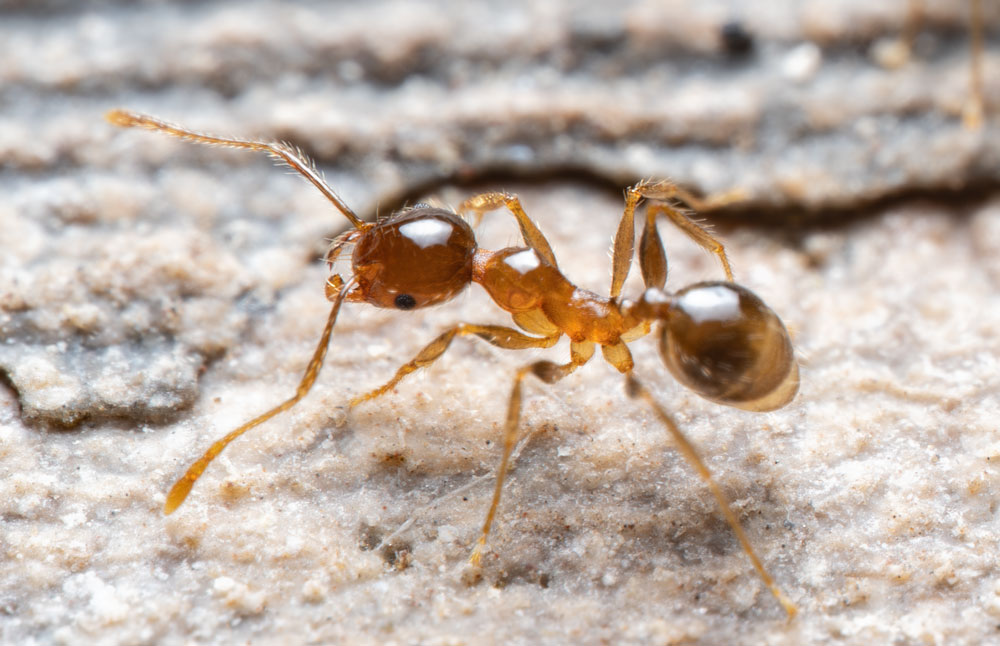
African Big-headed Ant
African Big-headed Ant
Species Info General
Other common names include: Black-headed Ant
The most common ant on kitchen counters in Hawai‘i is probably the African Big-headed Ant. In his 1915 book “Natural History of Hawaii”, W. A. Bryan noted that this ant “invades every nook and corner of the house and considers the food safe and ice-box as institutions especially provided for its comfort and convenience”. This ant has been tramping around the world as a stowaway pretty much since the first ship sailed across an ocean. It was spreading through the Hawaiian Islands by the middle of the 19th Century, and in the 1890s it was noted with alarm that native insects were being exterminated in droves as this ant spread through native lowland forests. Along with its less common but nearly identical cousin, Pheidole fervens, Big-headed Ants are nearly ubiquitous on all islands from sea level to around 500 meters elevation, and it continues to be commonly found up to twice that elevation or even slightly higher, although the higher ones goes the colder temperatures prevent it from thriving. Above about 1250 meters it tends to disappear altogether. Today there is widespread consensus that African Big-headed Ants are one the most invasive ant pests the world has ever known.
African Big-headed Ants are omnivorous, being both scavengers and predators. They obtain protein by consuming carrion and aggressively preying upon other arthropods. They get their carbohydrate fixes by farming aphids and related hemipterans for their sugary secretions, including banana aphids that spread Banana Bunchy Top Virus. In the kitchen, any crumbs or spilled droplets of proteins, oils or sugars are quickly found by foraging ants.
With such a widespread footprint in the Islands, African Big-headed Ants are not targeted for eradication by MISC or any other agency. Fortunately, they tend to respond readily to many ant baits available at most any hardware or garden store.


Identification/Description
African Big-headed Ants are a very stereotypical, non-descript ant. Its common name pays homage to the extraordinarily large heads of the major caste, though the great majority of the ants you encounter will be minors have normal-sized heads. This brownish ant is dark, but not quite black, and is usually fairly uniformly colored though sometimes with a slightly darker gaster. It often travels in lines with scores to hundreds of ants going back and forth, moving at a “normal” ant pace – neither excessively quickly nor noticeably sluggishly. Out of doors one can often see lines of disturbed soil along the sides of their tracks where they have moved sand, small pebbles and bits of dirt out of their way. At the entrances to their subterranean chambers is often a circular pile of fine dirt.
Impacts
- African Big-headed Ants aggressively prey on native arthropods, interfering with the balance of predators, prey and pollinators in our native ecosystems.
- This species’ voracious predation on native arthropods is thought to have played a role in the decimation of Hawaii’s native lowland birds during the mid to late 19th Century.
- They promote the proliferation of aphids, scale, mealybugs and related species that often cause agricultural damage.
- They are a significant nuisance in the home.
History
- African Big-headed Ants were one of the seven ants listed in the first article to scientifically annotate the ants known to be in Hawaiʻi, published in 1879. At that time it was already “said to be one of the commonest Ants in the Sandwich Islands”. The noted British entomologist and ornithologist R.C.L. Perkins, who studied Hawaiʻi’s native fauna starting in the early 1890s, witnessed first-hand the ant spreading across the landscape. In 1913 he called it “the most abundant of all the foreign ants”. He further wrote, “Miles of attractive forest in some parts of the islands are almost devoid of native insects, through its destructiveness” and that “This native fauna, especially of beetles, appears as if by magic, the moment the limit of range of Pheidole is reached”. Despite its horrific impact on native arthropods, some observers have noted that this species performs at least some service to humanity in that it is known to predate the larvae of a number of even less welcome species, such as houseflies, cockroaches and fleas. Still, on the balance, this ant is not welcome in the Islands.
Resources/References
- Maui Invasive Species Committee’s Brief Guide to Maui’s Ants – Phedole megacephala – AntWiki
- Bryan, W. A. 1915. Natural History of Hawaii. The Hawaiian Gazette Co., Honolulu. 596 pp.
- Perkins, R. C. L. 1913. Fauna Hawaiiensis – Introduction. Cambridge University Press,
- London. 1(4): 1–228.
- Wetterer, J. K. 2007. Biology and Impacts of Pacific Island Invasive Species. 3. The African Big-Headed Ant, Pheidole megacephala. Pacific Science. 61(4):437–456.
